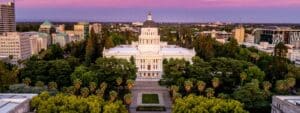Zusha Elinson
New emissions targets ratchet up anti-sprawl movement
Killing the suburbs to save the environment is becoming a popular idea.
With the state air board expected to set tough new regional targets for greenhouse gas emissions later today, the agitation for an urban planning solution to climate change is growing even stronger.
Just yesterday, a new report called Vision California found that building housing developments in cities and near public transit instead of car-happy suburbs could cut greenhouse gas emissions by 17 percent by 2035.
“In California, transportation is the greatest contributor to greenhouse gas emissions at about 40 percent,” said Stephanie Reyes, policy director of the Greenbelt Alliance in San Francisco. “The type of neighborhood you live in has an enormous effect on how much you drive.”
The push for so-called smart growth is coming from Sacramento in the form of SB 375, a 2008 anti-sprawl law that calls for smart growth, regional planning and the new emissions targets. In addition, advocates contend that people don’t really want to live in the suburbs anymore.
“There is a shift in attitude about where people want to live,” said Katherine Perez of the Urban Land Institute in Los Angeles. “They want to live in places that are more urban or at least urban lite.”
But actually building transit-oriented development is another story. And no one knows this better than the author of the Vision California report, Berkeley urban planner Peter Calthorpe. His designs for a dense, walkable development with 4,500 units of housing on an abandoned Naval Air Station on the island of Alamada have been stymied.
“Even thought the market forces are pushing in this direction and certainly it would be good from an environmental standpoint, the problem is that the local zoning is out of date and local politics tends to be backward-looking,” said Calthorpe.
City residents voted resoundingly against the Alameda Point development in February. The developer, SunCal, put Measure B on the ballot. The initiative would have made exception to the island’s low-density zoning. But voters didn’t like the way SunCal seemed to be trying to go around the normal planning process to get the project through.
As the state’s anti-sprawl bill rolls out, local governments may have less power to stop big infill developments. The law could streamline the approval of projects if they fit into the region’s plan for smart growth. And there could be incentives for cities to follow the regional plans that are now in the process of being created.
“SB 375 just changes the legal structure,” said Calthorpe. “The regions have to create plans, and if the cities don’t go along with it, everyone loses by losing funding.”
Still, SB 375 isn’t a sure bet for the future, with its raison d’être, the climate change bill AB 32, under attack from oil companies. A proposition — sponsored in large part by Valero — that would essentially repeal AB 32 just qualified for the ballot.
Calthorpe and others believe market forces will encourage more transit-oriented development regardless of the law. But if that doesn’t happen, the Vision California report predicts some dire results. If planning continues to follow current trends, with large, single-family homes dominating development, greenhouse gas emissions will increase 0.6 percent by 2035 and 10 percent by 2050.




